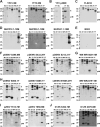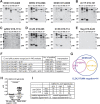Detection of anti-premembrane antibody as a specific marker of four flavivirus serocomplexes and its application to serosurveillance in endemic regions
- PMID: 38163752
- PMCID: PMC10810658
- DOI: 10.1080/22221751.2023.2301666
Detection of anti-premembrane antibody as a specific marker of four flavivirus serocomplexes and its application to serosurveillance in endemic regions
Abstract
In the past few decades, several emerging/re-emerging mosquito-borne flaviviruses have resulted in disease outbreaks of public health concern in the tropics and subtropics. Due to cross-reactivities of antibodies recognizing the envelope protein of different flaviviruses, serosurveillance remains a challenge. Previously we reported that anti-premembrane (prM) antibody can discriminate between three flavivirus infections by Western blot analysis. In this study, we aimed to develop a serological assay that can discriminate infection or exposure with flaviviruses from four serocomplexes, including dengue (DENV), Zika (ZIKV), West Nile (WNV) and yellow fever (YFV) viruses, and explore its application for serosurveillance in flavivirus-endemic countries. We employed Western blot analysis including antigens of six flaviviruses (DENV1, 2 and 4, WNV, ZIKV and YFV) from four serocomplexes. We tested serum samples from YF-17D vaccinees, and from DENV, ZIKV and WNV panels that had been confirmed by RT-PCR or by neutralization assays. The overall sensitivity/specificity of anti-prM antibodies for DENV, ZIKV, WNV, and YFV infections/exposure were 91.7%/96.4%, 91.7%/99.2%, 88.9%/98.3%, and 91.3%/92.5%, respectively. When testing 48 samples from Brazil, we identified multiple flavivirus infections/exposure including DENV and ZIKV, DENV and YFV, and DENV, ZIKV and YFV. When testing 50 samples from the Philippines, we detected DENV, ZIKV, and DENV and ZIKV infections with a ZIKV seroprevalence rate of 10%, which was consistent with reports of low-level circulation of ZIKV in Asia. Together, these findings suggest that anti-prM antibody is a flavivirus serocomplex-specific marker and can be employed to delineate four flavivirus infections/exposure in regions where multiple flaviviruses co-circulate.
Keywords: Yellow fever virus; antibody; flavivirus; premembrane protein; serosurveillance.
Conflict of interest statement
No potential conflict of interest was reported by the author(s).
Figures



Update of
-
Detection of anti-premembrane antibody as a specific marker of four flavivirus serocomplexes and its application to serosurveillance in endemic regions.medRxiv [Preprint]. 2023 Sep 25:2023.09.21.23295701. doi: 10.1101/2023.09.21.23295701. medRxiv. 2023. Update in: Emerg Microbes Infect. 2024 Dec;13(1):2301666. doi: 10.1080/22221751.2023.2301666. PMID: 37808865 Free PMC article. Updated. Preprint.
Similar articles
-
Identification of West Nile virus infection by anti-premembrane antibodies in Nicaraguan children prior to 2007-2009.Microbiol Spectr. 2025 Jul;13(7):e0004725. doi: 10.1128/spectrum.00047-25. Epub 2025 May 22. Microbiol Spectr. 2025. PMID: 40401969 Free PMC article.
-
Detection of anti-premembrane antibody as a specific marker of four flavivirus serocomplexes and its application to serosurveillance in endemic regions.medRxiv [Preprint]. 2023 Sep 25:2023.09.21.23295701. doi: 10.1101/2023.09.21.23295701. medRxiv. 2023. Update in: Emerg Microbes Infect. 2024 Dec;13(1):2301666. doi: 10.1080/22221751.2023.2301666. PMID: 37808865 Free PMC article. Updated. Preprint.
-
Identification of Anti-Premembrane Antibody as a Serocomplex-Specific Marker To Discriminate Zika, Dengue, and West Nile Virus Infections.J Virol. 2021 Sep 9;95(19):e0061921. doi: 10.1128/JVI.00619-21. Epub 2021 Sep 9. J Virol. 2021. PMID: 34232731 Free PMC article.
-
The magnitude of flaviviruses infection in Ethiopia: a systematic review and meta-analysis.BMC Infect Dis. 2025 Aug 8;25(1):997. doi: 10.1186/s12879-025-11443-y. BMC Infect Dis. 2025. PMID: 40781295 Free PMC article.
-
Antibody tests for identification of current and past infection with SARS-CoV-2.Cochrane Database Syst Rev. 2022 Nov 17;11(11):CD013652. doi: 10.1002/14651858.CD013652.pub2. Cochrane Database Syst Rev. 2022. PMID: 36394900 Free PMC article.
Cited by
-
Identification of West Nile virus infection by anti-premembrane antibodies in Nicaraguan children prior to 2007-2009.Microbiol Spectr. 2025 Jul;13(7):e0004725. doi: 10.1128/spectrum.00047-25. Epub 2025 May 22. Microbiol Spectr. 2025. PMID: 40401969 Free PMC article.
-
NSUN2-mediated HCV RNA m5C Methylation Facilitates Viral RNA Stability and Replication.Genomics Proteomics Bioinformatics. 2025 May 10;23(1):qzaf008. doi: 10.1093/gpbjnl/qzaf008. Genomics Proteomics Bioinformatics. 2025. PMID: 39957240 Free PMC article.
References
-
- Pierson TC, Diamond MS.. Flaviviruses. In: Knipe DM, Howley PM, editor. Fields virology. 6th ed. Philadelphia: Lippincott William & Wilkins; 2013. p. 747–794.
-
- World Health Organization . Dengue and severe dengue. https://www.who.int/news-room/fact-sheets/detail/dengue-and-severe-dengue.
MeSH terms
Substances
Grants and funding
LinkOut - more resources
Full Text Sources
Other Literature Sources
Medical
Miscellaneous
